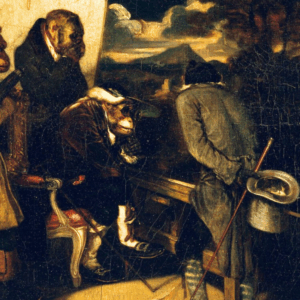
An Incomplete Biography of Jane Hirshfield in Six Jobs (with Poems)
Heather Swan on the Many Roles of a Poet, and Friend
1. Truckdriver and Farm Laborer.
After graduating college in 1973—the year Bob Dylan released “Mr. Bojangles,” the year of the Roe vs. Wade decision, the Watergate trial, the beginning of the end of the Vietnam War—Jane’s first job was doing farm work in Rocky Hill, New Jersey, work she shared with her college boyfriend, who taught her to drive in his Ford Bronco and then helped her turn her own first car—a red Dodge van—into a utopian space with wall-to-wall carpeting, tie-dyed curtains, and a built-in bed. She lived in it for months when she later drove across the country in search of her longer-term future, eight years of formal training in Zen.
During an interlude between leaving the monastery and returning to practice at Green Gulch, San Francisco Zen Center’s farm in Muir Beach, Jane drove a Ford cabover double-trailered eighteen-wheel lumber truck. She never tried to write about that, she says, because her friend “Gary Snyder’s ‘Why Log Truck Drivers Wake Up Earlier Than Students of Zen,’ said all that could be said.” But when she began teaching in the California Poets in the Schools program a few years later and needed the respect of the eighth-grade boys, she would sometimes mention, “When I was going up and down Highway 99 driving a lumber truck…” She also wrote many poems about trees.
1973
That winter we took turns stepping into
the barely started mornings to turn ignitions
until they caught, complaining roughly
of the cold, then ran
back to finish our coffee, cereal, toast,
while, chokes pulled full out,
exhaust poured white across the glass
that kept us warm…
We’d named them: Big Mama Tomato, Snooze.
Each was our first, as we
were each other’s first, in the farmhouse
for rent for the first time
in forty years surrounded by soybeans.
We’d whitedover the pink room the son
had painted when he returned crazed with Vietnam.
We’d made the man come back for the thin black lab
left chained in the yard.
The thirteen cats stayed, soon more, all wild.
Our own would come to the window by way of
a three story oak and mossshingled porch roof,
to mew us awake and them in every day:
Kesey & Mountain Girl, scrawling their signatures
snowmornings on the quilt.
We nailed planks from the old barns onto the walls
by our bed, scraped a dozen layers of peeling paper
from the next room the older they got,
the more lovely. That one we made cheerful yellow,
where I wrote the wildly sad poems of the very young.
When we got to the farm you took a tractor, I loaded
my van with sacks of produce & drove off.
Kip supervised us all: the Peace Corps vet, the kids
just out of school. Picking his peaches that summer
the best work I’ve done, the closest to Paradise
I’ve seen, ladderpropped in his trees.
All sold now, gone, his farm, the one we lived at,
the groundfall cider, the cars.
Us too, of course, long shaken free, though
I still cook bluefish the way you taught me, and carrots.
I thought I would love you forever and, a little, I may,
in the way I still move towards a crate, knees bent,
or reach for a man: as one might stretch
for the three or four fruits that lie in the sun at the top
of the tree; too ripe for any moment but this,
they open their skin at first touch, yielding sweetness,
sweetness and heat, and in me, each time since,
the answering yes.
(1987)
2. Volunteer Mounted Patrol Park Ranger and Wrangler of Mustangs.
Jane has loved horses all her life, including Tamara; Sunshine; Galahad; a Lusitano stallion in Portugal with whom she shared a memorable hundred-and-fifty-mile week; and Flame, the chestnut Arabian gelding she brought home from a rescue barn when he was five years old and kept at a boarding barn in Muir Beach until he died, in 2022, at age thirty-two. Flame was the horse-love of her life. When she speaks of him, she stares off down the trail. So many memories with him on this mountain. We were retracing paths Jane and Flame had climbed for years, many of them while serving as California State Park Volunteer Mounted Patrol. To this day, she rides with friends on their wild-born mustangs.
This poem is about Sunshine, a friend’s quarter horse she rode on the trails above Muir Beach for seven years:
The Love of Aged Horses
Because I know tomorrow
his faithful gelding heart will be broken
when the spotted mare is trailered and driven away,
I come today to take him for a gallop on Diaz Ridge.
Returning, he will whinny for his love.
Ancient, spavined,
her white parts red with hill-dust,
her red parts whitened with the same, she never answers.
But today, when I turn him loose at the hill gate,
with the saddle sweat rinsed off with water,
I know he will canter, however tired,
whinnying wildly up the ridge’s near side,
and I know he will find her.
He will be filled with the sureness of horses
whose bellies are grain-filled,
whose long-ribbed loneliness
can be scratched into no-longer-lonely.
His long teeth on her withers,
her rough-coated spots will grow damp and wild.
Her long teeth on his withers,
his oiled-teakwood smoothness will grow damp and wild.
Their shadows’ chiasmus will fleck and fill with flies,
the eight marks of their fortune stamp and then cancel the earth.
From ear-flick to tail-switch, they stand in one body.
No luck is as boundless as theirs.
(1992)
3. Chef.
Jane was a dinner chef at Greens Restaurant for the first three years after it opened. Founded by the San Francisco Zen Center in 1979 as a workplace for practicing Zen students, it was credited in The New York Times as “the restaurant that brought vegetarian food out from sprout-infested health food stores and established it as a cuisine in America.”
Jane said, “I only realized after I started being asked to contribute to food-themed anthologies, how many dozens of food poems I’ve written over my life. That includes a noticeable subset of strange-sandwich poems, which come from lunches I’ve been given during residencies at various artist colonies over the decades—everything from peanut butter, banana, and butter and cottage cheese on white bread sandwiches to some implausibly inventive and entirely delicious ones—one somehow-vegetarian pastrami-style sandwich on marbled bread I still crave to eat again. Coffee also shows up in all my books, often in a chipped blue mug. Also the plums, apricots, pears, apples, figs, and mulberries that grow in my garden—every tree has its poem, I think. It’s true that I was a cook, but I don’t write food poems because of those three years working in the Greens kitchen. I write food poems because I eat.”
She offered me a bowl of figs from her tree at a small table in her garden as we talked. You can find the full recipe for this poem’s soup in The Greens Cookbook.
Da Capo
Take the used-up heart like a pebble
and throw it far out.
Soon there is nothing left.
Soon the last ripple exhausts itself
in the weeds.
Returning home, slice carrots, onions, celery.
Glaze them in oil before adding
the lentils, water, and herbs.
Then the roasted chestnuts, a little pepper, the salt.
Finish with goat cheese and parsley. Eat.
You may do this, I tell you, it is permitted.
Begin again the story of your life.
(1996)
4. Mushroom forager (learner-of-the-names-of-things).
Jane likes discovering things. She’s become a forager of mushrooms in recent years. She knows five kinds well enough to trust her own identification of them—anything else, there’s a local expert she can bring things to. Her favorite foraged mushroom is spring amanita—a kind you really do need to know how to distinguish. Chanterelles feel like finding a treasure hoard, she said, and she also finds wild oyster mushrooms “astonishingly flavorful.” She’s a member of the Marin Mycological Society. “Once you begin to know the names of things,” she said on our hike,” they begin to show themselves to you more.”
Here’s a poem about lichen, written when she was poet in residence with the H.J. Andrews Experimental Forest on Oregon’s Western Cascades:
For the Lobaria, Usnea, Witches Hair, Map Lichen, Beard Lichen, Ground Lichen, Shield Lichen
Back then, what did I know?
The names of subway lines, busses.
How long it took to walk twenty blocks.
Uptown and downtown.
Not north, not south, not you.
When I saw you, later, seaweed reefed in the air,
you were grey-green, incomprehensible, old.
What you clung to, hung from: old.
Trees looking half-dead, stones.
Marriage of fungi and algae,
chemists of air,
changers of nitrogen-unusable into nitrogen-usable.
Like those nameless ones
who kept painting, shaping, engraving,
unseen, unread, unremembered.
Not caring if they were no good, if they were past it.
Rock wools, water fans, earth scale, mouse ears, dust,
ash-of-the-woods.
Transformers unvalued, uncounted.
Cell by cell, word by word, making a world they could live in.
(2010)
5. Firefighter.
In 1977, after waking to see the red light of dawn in a direction where dawn shouldn’t have been, Jane spent weeks helping to clear brush and digging fire breaks while waiting for the Marble Cone Fire to reach Tassajara, the Zen monastery where she then was living in the Ventana Wilderness inland from Big Sur. When the fire finally arrived at the ridge directly above, she was handed a flare to help start a protective backfire. The book “Fire Monks,” describes another fire, thirty years later, that Jane was also at Tassajara for the start of and helped the current residents begin to prepare for. In both, Tassajara survived.
Jane describes a forest fire as one of the largest – and most unexpectedly beautiful – things she’s experienced. But its meaning has changed over the decades, she said to me: “With climate change, fire has now become an ever-present risk. There aren’t thirty years between bad fire seasons anymore. The day the sky stayed red—in the Bay Area September 9, 2020, and again in New York in 2023—is seared into me. All day, streetlights and car headlights stayed on. You needed your house lights on. From morning to midday, it only got darker. I felt this not as some unusual condition, but as a pulling back of the curtain. We were seeing the actual, continuing state of the earth now, undisguised by the scrim of normality.”
The first poem below describes the invention of the backfire technique during the 1949 Mann Gulch Fire in Montana, the subject of Norman Maclean’s classic book Young Men and Fire. The second poem describes what has become for Jane an almost annual experience of her own garden in late summer and fall.
Heat and Desperation
Preparation, she thought,
as if a pianist,
limbering, stretching.
But fingers are tendon, not spirit;
are bone and muscle and skin.
Increase of reach extends reach,
but not what comes then to fill it.
What comes to fill it is something that has no name,
a hunger from outside the wolf-colored edges.
Thirteen smokejumpers died at Mann Gulch.
Two ran faster.
One stopped, set a match ahead of himself,
ahead of the fire. Then stepped upslope,
lay down inside still-burning ashes, and lived.
(2008)
Vestment
For the pear, for the fig,
no difference
they ripen
even in ashfall.
(2020)
6. Science Advocate.
Jane has a long history of bringing science into her work, going all the way back to “For What Binds Us,” a poem written in 1982 that draws some of its language from physics. She never took physics, she told me, and now regrets that. Over her life, she’s spent increasing amounts of time with scientists, serving as artist in residence for both a neuroscience program at UCSF and the experimental forest in Oregon’s Western Cascades and as a member of several long standing interdisciplinary conversation communities. Researchers working in many different fields are now among her closest friends.
In 2017, in response to the attack on science described in the poem below, she founded Poets for Science and stepped into the role of activist in a larger way. She read the poem at the March for Science in D.C., to an estimated 40-50,000 people on the Washington Mall. It was read by others at marches in Paris, Marseilles, Seattle, and, in Dublin, at that March’s close, by Mary Robinson, the former president of Ireland.
On the Fifth Day
On the fifth day
the scientists who studied the rivers
were forbidden to speak
or to study the rivers.
The scientists who studied the air
were told not to speak of the air,
and the ones who worked for the farmers
were silenced,
and the ones who worked for the bees.
Someone, from deep in the Badlands,
began posting facts.
The facts were told not to speak
and were taken away.
The facts, surprised to be taken, were silent.
Now it was only the rivers
that spoke of the rivers,
and only the wind that spoke of its bees,
while the unpausing factual buds of the fruit trees
continued to move toward their fruit.
The silence spoke loudly of silence,
and the rivers kept speaking
of rivers, of boulders and air.
Bound to gravity, earless and tongueless,
the untested rivers kept speaking.
Bus drivers, shelf stockers,
code writers, machinists, accountants,
lab techs, cellists kept speaking.
They spoke, the fifth day,
of silence.
(2017)
*
Jane Hirshfield is one of the world’s finest poets. The author of ten books of poetry, most recently The Asking: New & Selected Poems (Knopf, 2023), as well as two now-classic collections of essays on poetry’s deep workings, Nine Gates and Ten Windows, and four books collecting and co-translating world poets of the deep past, she’s received fellowships from the Guggenheim and Rockefeller foundations, the National Endowment for the Arts, and the Academy of American Poets, and has served as a Chancellor of the Academy of American Poets. She’s been a visiting professor at Stanford University, U.C. Berkeley, Queen’s University, Belfast, and more. In 2019, she was elected into the American Academy of Arts & Sciences.
Heather Swan
Heather Swan is the author of the nonfiction books Where the Grass Still Sings: Stories of Insects and Interconnection and Where Honeybees Thrive: Stories from the Field (winner of the Sigurd F. Olson Nature Writing Award) and two books of poetry, A Kinship with Ash and Dandelion. Her recent essays can be found in The Sun, Emergence Magazine, and About Place Journal. She lives and works in Madison, Wisconsin.












